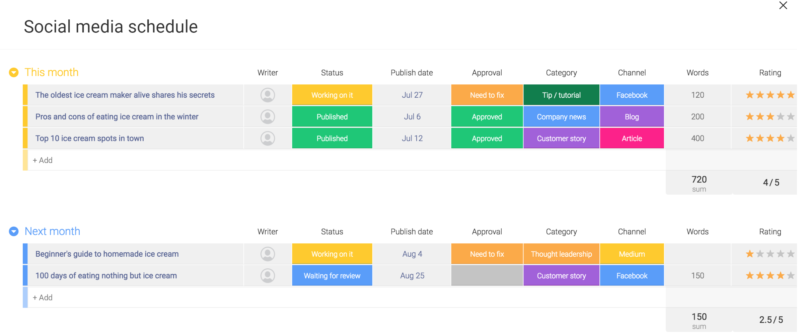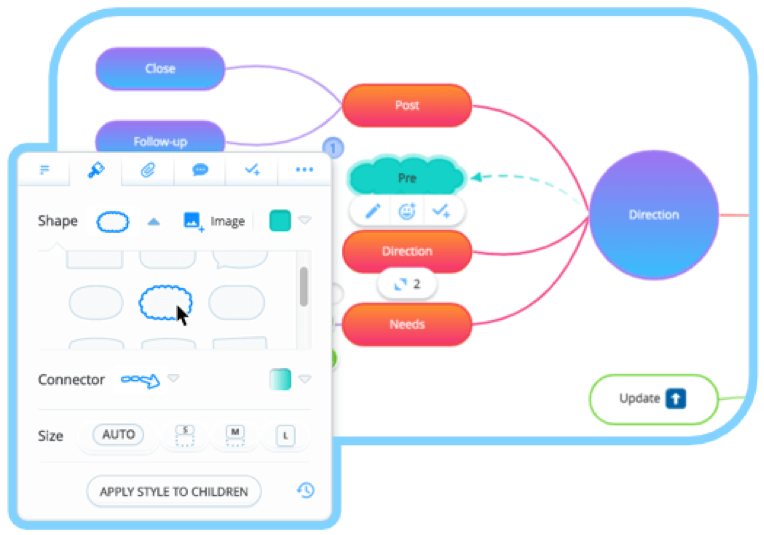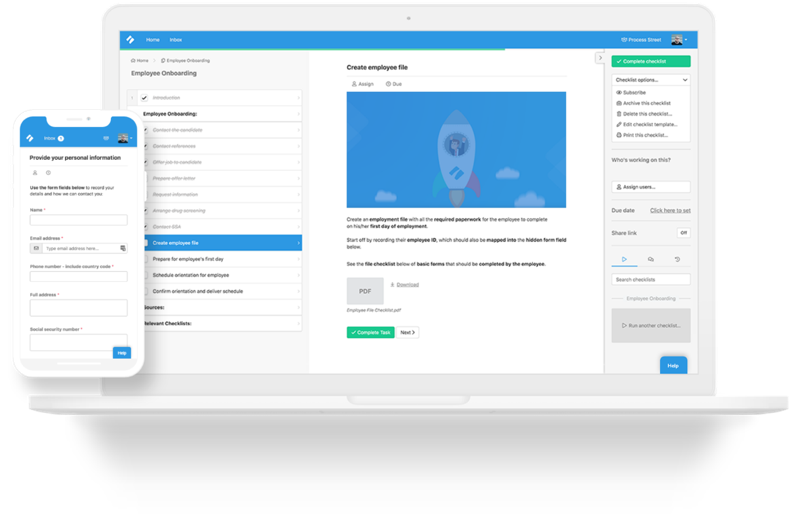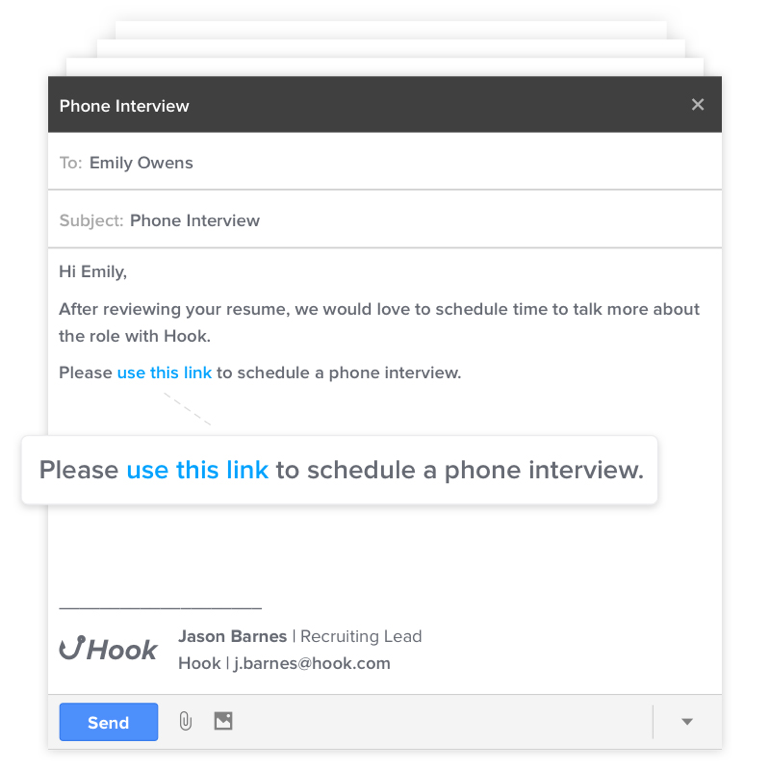“Systemization” is a popular buzz word right now, and maybe one you haven’t had much interest learning how to systemize your business up to this point.
When you have a small business – and especially if you’re just starting out – systems may not be all that necessary, and the idea of sitting down and creating and documenting all your processes can feel overwhelming.
However, if you want to grow your business, it becomes absolutely, 100% necessary to systemize.
So…what does this look like?
What IS systemizing exactly?
Are there any tasks or areas of your business do you need to systemize?
In this post, you’ll learn everything you need to know about systemizing your small business including:
- What is systemization?
- Why systems are so important for your business growth and success
- The #1 sign it’s time to systemize your business
- A 6-step process to systemize your business
- The best tools to help you systemize
- The best tools to help you automate your systems
As a small business owner, it can be easy to get caught up simply working IN your business. But, I hope that by the end of this post, you’ll feel inspired to work ON your business – on growing and scaling it by making systems a core part of how you run your business.
What is Systemization?
To put it simply, systemization is having a documented, repeatable process for how to complete a particular task.
A good system should lay out each step of the process, including who is responsible for each step, what tools or resources they will be using, and when those tasks will occur.
For instance, a system for your social media might be:
- Denise plans out 30-days of social media content, then emails outline to Jack by the 1st of each month.
- Jack creates the visuals for social media posts, and posts to team Slack group by the 7th of each month.
- By the 10th of each month, Lee schedules 30-days’ worth of social media posts in Agorapulse.
As you can see, the system includes names, dates, and tools used, where relevant.
The more explicit and detailed each step is, the better. This leaves far less room for error, confusion or for important stuff to fall through the cracks!
Why Are Systems So Important?
According to research, approximately 96% of companies use some type of documented process or system within their business.
[click_to_tweet tweet=”According to research, approximately 96% of companies use some type of documented process or system within their business.” quote=”According to research, approximately 96% of companies use some type of documented process or system within their business.” theme=”style6″]With numbers this high, it’s clear there must be some MAJOR benefits to using systems!
But, besides helping to avoid mistakes, what else is systemization good for?
Let’s take a look.
1. It takes the pressure off of you.
As a business owner, the buck stops with you.
If you get sick or need to take some time off, what happens to your business?
Having systems in place means you can be more far more hands-off when it comes to running your business.
You can start outsourcing tasks or building a team and be assured that whoever is responsible for those tasks knows exactly what to do – because they’re following the exact process you put in place.
2. It helps you spot gaps.
When you have systems in place, it becomes much more obvious when things are falling through the cracks.
Some gaps you may be able to spot include:
- People or resources that aren’t being used to their full potential
- Timing issues – like assigning too much or too little time to certain tasks
- Recurring tasks that just aren’t being done efficiently
- The cause of backlogs or jams within your output: for instance, systems let you see exactly where, when or who may be contributing to these.
Part of identifying gaps is making sure your team members know you’re open to feedback on the existing system. Keep a running list of suggestions and make changes and additions on an ongoing basis to keep everything running smoothly!
3. It builds consistency in your business.
Having systems means greater consistency in output, regardless of who’s completing a task or process.
This is particularly important when it comes to client work: making sure each client gets the same quality of work, and that each project or task is done consistently.
This is also good for your side of the business, as you can count on work getting done in a certain amount of time, with a predictable investment of resources…no guesswork required!
4. It makes training much easier.
When you hire new team members or want to start outsourcing work, having systems in place makes the whole process so much easier.
When you hire new team members or want to start outsourcing work, having systems in place makes the whole process so much easier.
Instead of spending a ton of time answering questions and trying to explain to new hires what they need to do, you can simply walk them through a document that outlines the relevant system(s)…saving you all time, money and frustration.
While this won’t make training completely hands-off, it will definitely give you a solid foundation and help to ensure training new hires goes off without a hitch!
5. It gives your team members more freedom and flexibility.
At first, this may sound counterintuitive. How do systems and processes give your team members MORE freedom and flexibility?
First, when you have systems in place, there’s no need to micro-manage your team. They know exactly what they need to do and when they need to do it…no hand-holding required.
Second, because all the basics are in place, they don’t need to waste time trying to reinvent the wheel; instead, they have the flexibility and are able to be more creative in actually working on the stuff they’re good at.
For instance, instead of worrying about how long a blog post should be, or when it needs to get published, or who will be promoting it, your blog writer can focus on what he or she loves and what you hired them for – actually WRITING the blog post!
6. It saves you money.
According to research done by a Polish consulting firm, around half of companies use business processes mainly as a way to reduce costs.
[click_to_tweet tweet=”According to research done by a Polish consulting firm, around half of companies use business processes mainly as a way to reduce costs.” quote=”According to research done by a Polish consulting firm, around half of companies use business processes mainly as a way to reduce costs.” theme=”style6″]Having processes and systems in place not only reduces redundancy, but also increases efficiency, and reduces the time it takes to train new hires, which leads to continual improvement within your business.
And, if this isn’t reason enough to start systemizing your business, I don’t know what is!
The #1 Sign its Time to Systemize Your Business
Obviously, there are tons of benefits that come along with systemizing your business.
But, does this mean the process is right for everyone?
Should every small business owner reading this immediately jump in and start creating and documenting processes and procedures for their business?
Not necessarily.
If you’re a one-woman or one-man show, just starting out, documenting all your processes probably isn’t necessary.
While it can certainly still be helpful, you’re the only one performing all the recurring tasks in your business – so it’s much less likely certain steps or tasks are falling through the cracks.
However, if you’re thinking of expanding your team at any point in the near future…THIS is the #1 reason to start systemizing your business.
Having your systems in place beforeBEFORE you start hiring will make for a much smoother transition, as you’ll be able to tell your new hires exactly what they’re responsible for…
which will make the whole process so much easier for you and for them!
A Step-by-Step Process to Systemize Your Business
Okay. So you know you want to create systems within your business for all the reasons listed above.
But where do you start?
I’m going to share a super-simple (though admittedly, time-consuming) step-by-step process for creating systems for every key part of your business.
Keep in mind the process of systemizing isn’t something that has to be done overnight!
If you’re starting from scratch the entire process can take weeks or months – but don’t stress.
We’re going to start with the most critical areas of your business to get you off to the best possible start.
Step 1: Identify all the key areas of your business
Before you start the work of actually documenting your processes, it’s important to first identify each of the key areas or departments in your business.
For most small to medium-sized businesses, a look at the functional structure of your business will be the best way to get started. The different functional areas you may have within your business include:
- Human resources
- Finance
- Marketing
- Operations
- Information Technology
- Sales
- Purchasing
- Customer Service
Of course, most small businesses won’t have dedicated departments or even staff for each of these functional areas.
BUT, even if you’re doing everything yourself, noting down every area of your business is the key to identifying all of your processes – so don’t rush through this step!
Step 2: Identify the key recurring tasks within each functional area
For each functional area above, you’re going to identify each and every task you can think of that you do on a regular basis. No need to identify one-off tasks, but do include tasks that – while infrequent – do happen on a regular cycle (e.g., preparing annual financial statements).
Let’s run through an example together by looking at some possible tasks under the umbrella of finance.
Some tasks you may regularly complete include:
- Preparing an annual budget
- Paying employees or contractors
- Creating a monthly cashflow forecast
- Paying invoices (Accounts Payable)
- Issuing invoices (Accounts Receivable)
- Completing and filing an annual tax return
- Completing an annual audit
- Monthly reconciliation of the books
You may have fewer tasks related to finances, but chances are you have a number of these.
Hopefully, this step is pretty clear at this point. Go through each of the functional areas listed in step 1 and note down every single regularly-occurring task you can think of!
Step 3: Document the process of completing each of the tasks above
This step is going to take a while, so get comfy.
Now, at this point, you may not even have a set process for completing each of the tasks, and that’s perfectly okay. That’s why we’re doing this!
Because it’s going to take you a while to document every single task, start by identifying the tasks that happen most often, and that is most important to the growth of your business.
Starting with the most important and frequent tasks, note down the process you use to complete them – from the very start to finish.
It’s important to be as specific as possible here, noting down ALL the key info for each task, including:
- WHAT triggers the task (e.g., a particular date, receiving something in the mail, etc.)
- WHO is responsible for each step in the task (e.g., the marketing manager, content creator, etc.)
- WHEN the task needs to happen (e.g., on the 1st of each month)
- HOW to complete the task (including tools and resources needed)
If you don’t already have a process in place, this is the time to create one! And if you do have one, note it down in as much detail as you can, getting input from team members along the way.
Let’s run through another example together by documenting the process of paying invoices.
- Bookkeeper receives the invoice in mail or by email and immediately enters it into the Accounts Payable module in QuickBooks.
- Principal (that’s you!) looks through the Accounts Payable module on the 15th and 30th of each month and approves invoices.
- Bookkeeper prints check for approved invoices on the 1st of the month.
- The bookkeeper brings checks to principal to sign on the 1st of the month.
- Bookkeeper mails check to vendors by the 2nd of each month.
You’ll notice that for each step, we’ve identified WHO is responsible (bookkeeper or principal), WHEN they need to do it (e.g., 1st of each month), and any TOOLS that are needed (e.g., QuickBooks).
We’ve also identified what TRIGGERED the process of paying the invoices (receiving them via mail or email).
Step 4: Create checklists for your processes (optional)
As part of the process of documenting your systems, you may also want to create checklists for certain tasks.
These can be particularly useful for high-stakes tasks, complex processes, or as tools to be used to help train new team members.
In his book, The Checklist Manifesto, Atul Gawande goes into great detail about how checklists can be used to avoid mistakes and ensure consistency. He believes most mistakes are made not because of ignorance, but because we don’t properly do what we know works.
And checklists are a tool that can be used to ensure everyone on our team consistently does what works!
Keep in mind that I’m NOT recommending checklists be used as a way to micromanage your employees: in fact, the only one who should see the completed checklists is the person actually doing the task.
They should be used as helpful guides…not as a way to spot your employees’ mistakes!
Step 5: Do a test run of each process
When you’re first documenting your processes, it can be easy to miss steps or leave out important info.
For this reason, it’s a good idea for you – or preferably, someone else – to run through each process to look for gaps.
Have them take notes as they go along, noting down any questions or thoughts they have.
Have them pay special attention to any wording that’s ambiguous or unclear, as these “little” mistakes can cause big problems later on!
Edit your final documents to reflect relevant changes or additions.
Step 6: Regularly review and improve your processes
When it comes down to it, one of the most important benefits of using business systems is the ability to consistently improve how you do things.
I highly recommend revisiting your processes at least once each year to make sure they’re still accurate. Because people, tools, and circumstances change over time, it’s important to regularly ensure your procedures are up-to-date.
It’s also important to be open to making changes on an as-needed basis – so make sure your team members know your processes aren’t written in stone, and that they should feel free to suggest changes whenever they think something could be done better.
Tools to Help Create Systems for Your Business
Using the right tools is absolutely KEY when trying to systemize your business.
To be clear, business tools and software are NOT business systems in and of themselves!
However, tools do allow you to create and document your systems, leading to greater consistency and repeatability within your business.
Following are 6 tools you can use to start documenting and tracking your processes today.
1. Monday.com
Monday.com is a project management platform used by both small businesses, as well as big companies like WeWork, Wix.com, the Discovery Channel and even my own team.
It basically lets you create and input all your workflows and processes to ensure your entire team is on the same page at all times.
One thing I love about Monday.com is their pre-designed templates. These are GREAT if you haven’t yet created your systems, and need a little extra help.
They have templates for marketing (see screenshot above), operations, HR, IT and more. Simply edit the templates to suit your specific business processes, and you’re off to the races!
Price: 14-day free trial available. Paid plans start as little as $17 per month for up to 2 users. Worth every penny!
2.Manifestly
In step 4, I talked about how checklists can be used to ensure consistency and repeatability of tasks.
A great tool to help with creating standardized processes for your business is Manifestly.
It allows you to easily create workflows for common tasks, and then set up checklists your entire team can work from. You can even assign different tasks to certain people – whether that’s internal team members or clients.
I also love that the tool lets you add photos or videos to steps for added clarity and that it integrates with Slack – which means your team can keep track of checklists right from within your Slack channel.
Price: Starts at $25/month for up to 5 people.
3. Ayoa
As you start brainstorming the different functional areas and processes in your business, using online mind mapping software can be really helpful.
Ayoa is a tool that will let you create visual representations of your ideas…and basically just get all your ideas onto paper.
You can also use Ayoa to create flow charts for your business processes – for instance, to create a chart that graphs the process of creating a blog post, or creating a Facebook ad.
Price: Starts at $10/month for a single user.
4. SweetProcess
If you’re looking for a user-friendly tool to help you quickly document your processes and track your team’s progress, you should definitely check out SweetProcess.
This tool basically lets you create your very own interactive operating manual, complete with pictures, videos, checklists, and activity tracking.
This is probably one of the most user-friendly tools on this list, so it's worth checking out if you want something that’s not too “techy” and doesn’t have a big learning curve.
Price: 14-day free trial available. Plans start at $82.50/month for teams with up to 20 active members.
5. Process Street
Like other tools on this list, Process Street lets you easily document your processes, create checklists, and track your team’s progress.
I love that Process Street also uses “conditional logic” in their checklists. This feature means you can essentially tailor your checklists based on the answer to a team member’s question: for instance, if they select that “Yes, the client has been contacted”, it will automatically adjust the rest of the process to reflect that this has already been done.
Process Street also comes with a full suite of collaboration tools, meaning you can easily keep track of what still needs doing, and who needs to do it.
Price: Starts at $12.50 per user, per month.
Trainual is a tool that lets you create an online training manual for your company. When you hire a new team member, you simply assign them to a particular role or department within the app, and they automatically have access to all the processes and procedures they’ll need to perform.
Along with Sweet Process, this is one of the most user-friendly tools on my list; so it’s a great option if you’re looking for something you can start using right away.
I also love that your team members can ask questions within the tool – as this means your training manual is constantly evolving, and always relevant!
Price: Starts at $83/month for up to 25 employees.
Tools to Help you Automate your Systems
While the tools above are all geared at the process of actually creating and documenting your systems, there are a ton of amazing tools out there that will help you automate your systems.
While documenting your processes is important, you also want to make sure recurring tasks aren’t eating up your time unnecessarily.
And, this is where automation comes in. Following are 5 tools you can use to automate your social media, email marketing, customer service and more.
Automate your social media with Agorapulse
If you’ve been following me for a while, you’ll already know how much I love Agorapulse.
It allows me to automate my social media marketing so my posting and scheduling are essentially on auto-pilot…allowing me to focus on other areas of my business.
Some of my favorite automation features include:
- The ability to schedule my evergreen posts for optimal engagement. Do you know those posts that consistently get tons of likes, comments, retweets, and shares? With Agorapulse, you can set these posts up in a queue so they’ll get sent out at regular intervals.
- The ability to schedule my Instagram stories. I can set up my stories within the app, then select when I want a post reminder. I then get a push notification when it’s time and simply go in and hit publish!
- The option to use the content queue. This lets me go in, create all my social media content, put them in the order I want, and then forget about it. It’s all done for me, without me having to constantly check in to post. Love it!
Price: Starts at $89/month for up to 2 users and 10 social profiles.
Automate your email marketing with Active Campaign
Email marketing can take up a LOT of time…especially if you’re not using the right tools.
There are some good, low-cost tools out there like MailChimp and aWeber, which are great for when you’re just getting started.
But if you’re looking to completely automate your email marketing, I would definitely consider upgrading to a tool like Active Campaign.
Some of their marketing automation features include:
- The drag-and-drop automation builder. This lets you easily set up automated campaigns that will send emails depending on different triggers: for example, when someone signs up for your list, clicks a certain link, or doesn’t open your emails for a while.
- Goal tracking. Set specific goals so that when your subscribers take certain actions, they’ll automatically be moved to the right part of your sales funnel.
- Automation maps. These lets you see exactly how your automation is working – or not working – together.
Price: Starts at $15/month for the Lite version, up to 500 contacts.
Automate your customer service with Zendesk
Responding to customer emails and requests can quickly become overwhelming and inefficient.
However, a tool like Zendesk can make the process of customer service SO much easier and more efficient by:
- Tracking customer service support tickets all in one place
- Allowing you to create a knowledge-base customers can refer to…hopefully, BEFORE they contact you
- Letting customers contact your customer service in real-time via chat or phone
- Allowing you to create workflows to guide customers to the help they need…automatically.
Price: Starts at $5 per agent, per month.
Automate your sales funnels with ClickFunnels
You likely already know that one of the best ways to automate your sales is with a sales funnel. These are essentially automated email sequences that lead your subscribers through a journey from signing up to your list, all the way to (hopefully) buying your product or service.
One of the key elements of a successful sales funnel is being able to convert visitors to leads and eventually customers. Wouldn't it be great if you can do all of that without hiring a tech team?
ClickFunnels was developed by entrepreneurs for entrepreneurs so they “get” you. They made it super easy to create a sales funnel on your own and effectively solved the tech side of setting up a sales funnel. No coding required to create a beautiful page that will guide your customers through the sales process in a seemless way so they don't get lost or confused.
It allows you to point your customers to a product or service you provide and also gives you a way to follow up with your customers after they leave your site.
ClickFunnels gives you all you need to create a funnel with a simple drag and drop feature, smart shopping cart with 1 click upsells, email and marketing automation features and more.
Automate your scheduling with Calendly
The whole process of going back and forth with clients when it comes to booking appointments can be a real time-waster. Just when you think you’ve FINALLY found a suitable time to meet, they email you (yet again) to re-schedule!
Calendly is an automated scheduling tool that eliminates all the “back and forth” hassle of making appointments.
Here’s how it works: You create different types of events, like 1-hour consultations, 30-minute discovery calls, or even webinars or group coaching sessions. You can then indicate exactly when you’re available, and your clients can go into your calendar and book their own appointment.
It’s that easy! You are then both automatically sent reminders of the appointment, reducing no-shows and last-minute cancellations.
Price: The basic version is free, and paid plans start at just $8 per user, per month.
How to Start Building a Team or Outsourcing
As I’ve mentioned throughout this article, one of the key benefits to systemizing your business is that it makes the process of outsourcing, hiring and training SO much easier.
It’s also the #1 motivator for businesses to start systemizing – as they want to have all their processes created and documented before they start bringing on new team members.
But as a small business owner, the whole idea of building a team or outsourcing work can feel overwhelming.
Which tasks should you outsource?
Where do you start with finding competent, reliable people to join your team?
Once you’ve hired people, what tasks should you delegate…and how exactly should you delegate them?
Because these are such important questions, I will be writing a series of blog posts to answer them in detail. You can check my first one here:
10 Steps to Build a Team When You Have No Clue How to Get Started
How to Turn Repeating Tasks Into a Business Process that You Can Delegate to a Team
5 Strategies to Delegate Tasks Effectively (and Boost Your Productivity)
Successfully Manage a Remote Team With These 10 Tips
Final Thoughts
Are you ready to systemize your business?
I trust this post has given you not only the motivation to systemize your business but the knowledge and tools to help you get started.
The process of systemization isn’t something that happens overnight – it’s a long-term endeavor.
But once you get your first systems set up and start to see how much more efficient you – and especially your team members – are, you’ll wonder why it took you so long to get started!
Are you going to start systemizing your business? Where are you going to start? Let me know in the comments below!
About Author
Kim Garst
Kim Garst is a renowned marketing strategist and speaker who is trailblazing the use of artificial intelligence in digital marketing. With over 30 years of experience as an online entrepreneur, Kim helps entrepreneurs grow their business and authority online by using AI technology. She is leading the way with proven AI frameworks that help entrepreneurs build authority in their space.
She is keynote speaker and an international best-selling author of Will The Real You Please Stand Up, Show Up, Be Authentic and Prosper in Social Media.
Named by Forbes as a Top 10 Social Media Power Influencer, Kim is well-known for her skill to simplify complex technology and make the use of AI understandable for business growth. Her relatable, actionable advice helps guide new entrepreneurs to harness the power of AI to succeed in digital marketing. Kim is leading the way in combining human and technological skills to create a new model for AI-powered marketing.


















6 thoughts on “How to Systemize Your Business to Grow and Scale in a Manageable but Profitable Way”
Thanks, awesome read! Hope you are staying safe!
Very useful article for systemizing the business.
Small businesses should go for digital marketing to run their business in this pandemic. great content thanks for sharing
Business automation is the way to go for every business now. This post helps to build a thought process.
Hi Kim!
Great post. Indeed, the best way to scale is through processes.
Thank you for sharing all these valuable suggestions! Glad I popped by your blog!